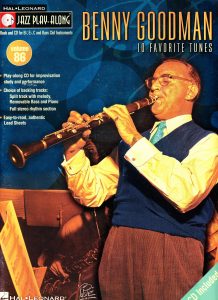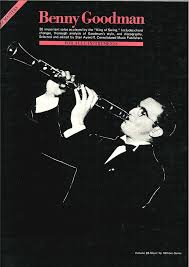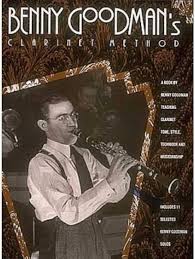Table of Contents
Come join us now, and enjoy playing your beloved music and browse through great scores of every level and styles!
Can’t find the songbook you’re looking for? Please, email us at: sheetmusiclibrarypdf@gmail.com We’d like to help you!
Happy birthday, Benny Goodman, born on this day in 1909.

Best Sheet Music download from our Library.
Benny Goodman: The King of Swing and the Architect of an Era
Benny Goodman, crowned the undisputed “King of Swing,” wasn’t just a brilliant clarinetist; he was a cultural catalyst who ignited a nationwide dance craze, shattered racial barriers in popular music, and elevated jazz to unprecedented levels of artistry and acceptance. His story is one of relentless dedication, musical perfectionism, and a pivotal moment in American history where jazz became the soundtrack of a generation. This extensive exploration delves into his life, sound, innovations, and enduring legacy.

Please, subscribe to our Library.
If you are already a subscriber, please, check our NEW SCORES’ page every month for new sheet music. THANK YOU!
I. Biography: From Chicago Tenements to Carnegie Hall
Born Benjamin David Goodman on May 30, 1909, in Chicago, Illinois, Benny emerged from a large, impoverished Jewish immigrant family. The harsh realities of tenement life made music an unlikely but crucial escape. At 10, he joined a boys’ band at the local synagogue, the Kehelah Jacob Synagogue, choosing the clarinet partly because instruments could be rented cheaply. His natural aptitude was immediately apparent. He absorbed the vibrant musical currents of Chicago – the burgeoning jazz scene influenced by New Orleans migrants, the sounds of dance halls, and the discipline of classical training.

- Early Apprenticeship: Goodman studied classically with Franz Schoepp (first clarinetist of the Chicago Symphony Orchestra) while simultaneously honing his jazz skills by transcribing solos from records and live performances. By his early teens, he was playing professionally in local bands, including those led by Bix Beiderbecke and Bill Grimm. His precocious talent earned him a spot in Ben Pollack’s popular orchestra in 1925, moving with them to California the following year. This was his national launchpad.
- New York Freelancer: By 1929, Goodman had established himself in New York City as a highly sought-after session musician. He played on countless records, radio broadcasts, and in pit orchestras, showcasing his impeccable technique and versatility across jazz, dance, and popular music. He recorded under his own name for the first time in 1926, but his sideman work (with Red Nichols, Ted Lewis, Isham Jones, and many others) was prolific.
- The Birth of the Benny Goodman Orchestra (1934): With the backing of jazz enthusiast and talent scout John Hammond, Goodman secured a weekly slot on NBC’s radio program Let’s Dance in 1934. Needing a band capable of playing three hours of diverse music weekly, he formed his first permanent orchestra. Crucially, Hammond steered Goodman towards arrangements by Fletcher Henderson, whose sophisticated, swinging charts for his own (all-Black) band had struggled commercially but were musically superior. Goodman, recognizing their brilliance, bought them wholesale, adapting them for his own ensemble.
- The Swing Revolution Ignites (1935): The Let’s Dance show provided national exposure, but the band’s initial tour in mid-1935 was rough. Audiences, particularly in the East and Midwest, were lukewarm until the pivotal night of August 21, 1935, at the Palomar Ballroom in Los Angeles. Facing a crowd of young dancers, Goodman cautiously started with stock arrangements. Encouraged by a positive response, he risked playing the hotter Henderson charts. The reaction was explosive. Teenagers rushed the bandstand, dancing with abandon. The Swing Era, fueled by Benny Goodman, had officially arrived. Radio broadcasts from venues like the Madhattan Room in New York cemented his national stardom.
- The Carnegie Hall Concert (January 16, 1938): This was perhaps Goodman’s single most significant achievement. Bringing jazz, still often viewed as lowbrow entertainment, to the sanctum of American classical music – Carnegie Hall – was a monumental gamble. The concert, meticulously planned and rehearsed, featured his big band, the Trio, and the Quartet. The program included new arrangements (like Edgar Sampson’s “Stompin’ at the Savoy”), recreations of Fletcher Henderson classics, jam sessions (“Honeysuckle Rose,” “Blue Skies”), and the climactic, extended “Sing, Sing, Sing.” The concert was a critical and popular triumph, definitively proving jazz’s artistic legitimacy. A live recording (though not released until 1950) remains one of the most iconic documents in jazz history.
- Integration Pioneer: Goodman’s commitment was to musical excellence, regardless of race. His hiring of pianist Teddy Wilson in 1935 (initially in the Trio) marked the first time a Black musician performed regularly with a white band. Vibraphonist Lionel Hampton joined the Quartet in 1936, and guitarist Charlie Christian became a revolutionary electric guitar voice in the Sextet in 1939. While not without friction (touring in the segregated South was perilous), Goodman insisted on their inclusion, breaking a significant color barrier in popular music.
- Later Career: The Big Band Era waned after WWII due to economic shifts and changing tastes. Goodman continued performing and recording prolifically, focusing more on small groups, reuniting his classic ensembles for special occasions, and increasingly exploring classical repertoire. He commissioned and premiered works by Bartók, Copland, Hindemith, and Bernstein, demonstrating his formidable classical technique. He remained a major international touring artist until his death from a heart attack on June 13, 1986.

II. Music Style: Precision, Swing, and Clarinet Virtuosity
Goodman’s style was built on a foundation of absolute technical mastery. His tone was pure, focused, luminous, and remarkably consistent across all registers. This technical perfectionism permeated his bands – they were renowned for their tight ensemble playing, precise section work (especially the legendary saxophone and brass sections), and impeccable intonation.
- Swing Personified: Goodman defined the swing aesthetic. His bands played with an irresistible, propulsive rhythm. The beat was strong and steady, driven by the rhythm section (initially Gene Krupa’s explosive drumming, later Jess Stacy’s smoother pulse, with Allan Reuss on guitar and later Charlie Christian, and Artie Bernstein or Harry Goodman on bass). The arrangements (primarily Henderson, but also Jimmy Mundy, Spud Murphy, Eddie Sauter later on) emphasized call-and-response between sections, dynamic contrasts, and riffs that built intensity.
- The Goodman Sound: Characterized by:
- Clarity and Balance: Every section was heard distinctly.
- Driving Rhythm: A powerful, danceable 4/4 beat.
- Sophisticated Arrangements: Complex harmonies and structures derived from Henderson, refined for precision.
- Virtuosic Solos: Goodman’s clarinet led the way, but his bands featured stellar soloists like Harry James (trumpet), Ziggy Elman (trumpet), Vido Musso (tenor sax), and of course, Wilson, Hampton, and Christian.
- The Small Groups: The Trio (Goodman, Wilson, Krupa), Quartet (adding Hampton), and Sextet (adding Christian and often others like Cootie Williams or Georgie Auld) were laboratories for more intimate, improvisational jazz. They showcased Goodman’s lighter, more playful side and allowed the individual virtuosity of his star sidemen to shine in a more conversational setting. These groups were incredibly popular and influential.
III. Improvisational Licks and Language
Goodman’s improvisational style was a masterful blend of technical fluency, blues feeling, and lyrical invention. Rooted in the Chicago style and early swing, he avoided the harmonic complexities of later bebop, focusing instead on melodic clarity, rhythmic drive, and the blues.
- Characteristics:
- Fluid Arpeggios: He effortlessly navigated chord changes using flowing arpeggiated patterns, often outlining the harmony clearly. Runs up and down the clarinet were common, executed with dazzling speed and precision.
- Blues Inflections: Bending notes (subtly on clarinet), using blue notes (flattened 3rds, 5ths, 7ths), and employing bluesy phrasing were central to his sound, especially in small group settings (“After You’ve Gone,” “Blues in Your Flat”).
- Sequencing: Repetition and variation of short melodic motifs, often moving them up or down in pitch.
- Rhythmic Vitality: Syncopation, driving eighth-note lines, and a strong sense of swing phrasing. He used space effectively but was generally a busy, energetic improviser.
- Lyrical Melodic Sense: Even at fast tempos, his solos often had a singing quality, memorable melodic phrases (“Body and Soul” solos).
- Signature Licks:
- Rapid Scale Runs: Particularly descending chromatic or diatonic runs ending with a bluesy scoop or bend.
- “Goodman Gliss” (Smear): A quick upward slide or smear between notes, often used as an expressive flourish, particularly in the upper register (famously opening “Let’s Dance”).
- Arpeggio-Based Bebop Precursors: While not bebop, some of his faster runs anticipated bebop’s scalar/arpeggio vocabulary, just within simpler harmonic contexts. Listen to his solos on “Rose Room” (1939) or fast small group tunes.
- Blues Riffs: Short, repeated blues phrases used as building blocks, often syncopated (“King Porter Stomp” solos).
IV. Chord Progressions and Music Harmony
Goodman’s music operated primarily within the harmonic language of the Swing Era:
- Functional Harmony: Dominated by standard major/minor key tonality, ii-V-I progressions, and blues forms (12-bar blues, 32-bar AABA song forms).
- Fletcher Henderson’s Influence: Henderson’s arrangements introduced a higher level of harmonic sophistication to popular dance bands. He used:
- Richer Chord Voicings: More complex chords (7ths, 9ths, 13ths) and denser textures in the saxes and brass.
- Chromaticism: Passing chords, secondary dominants, and altered chords for color and tension/release.
- Modulations: Smooth key changes within arrangements to add interest.
- Goodman’s Use: Goodman’s bands played these complex arrangements with precision. His own improvisation generally followed the underlying chord changes faithfully, focusing on melodic embellishment and rhythmic drive rather than radical harmonic substitutions. His solos were grounded in chord tones and diatonic scales/blues scales. The small groups, especially with Christian and Hampton, explored slightly more adventurous harmonies within the swing framework, particularly in blues and rhythm changes tunes.
- Common Progressions:
- 12-Bar Blues (I-I-I-I | IV-IV-I-I | V-IV-I-I or V): Foundational for countless tunes (“Blues in Your Flat,” “Swingtime in the Rockies” sections).
- Rhythm Changes (AABA: I-VI-ii-V | I-VI-ii-V | IV-iv-I-V7 | I-VI-ii-V): Based on Gershwin’s “I Got Rhythm,” a ubiquitous jam vehicle (“Limehouse Blues” often played over rhythm changes).
- Standard 32-Bar AABA: Used for countless pop songs and jazz standards (“Moonglow,” “Stardust,” “Body and Soul”). Harmony varied but relied heavily on ii-V-I progressions within each section.
V. Influences
Goodman absorbed influences from a wide spectrum:
- New Orleans Clarinetists: Johnny Dodds (for blues feeling), Jimmie Noone (for his smooth, fluid technique and vibrato – arguably Goodman’s single biggest clarinet influence).
- Chicago Style: Bix Beiderbecke (lyricism, tone), Frank Teschemacher (daring ideas, though Goodman’s style was more polished).
- Classical: His training with Schoepp gave him unparalleled technical control and tone production. He admired the clarity of classical phrasing.
- Fletcher Henderson: The single most profound influence on Goodman’s orchestral concept. Henderson’s arrangements provided the blueprint for the Goodman band’s sound and success.
- Sidemen: Goodman was shrewd in recognizing talent. Wilson influenced his small group piano interplay, Krupa defined the band’s early drive, and Christian revolutionized the band’s rhythm section and solo approach.
VI. Legacy: The Enduring King
Benny Goodman’s legacy is monumental and multifaceted:
- Catalyst of the Swing Era: He didn’t invent swing, but he popularized it on an unprecedented scale, making it the dominant American music for over a decade.
- Racial Integration Pioneer: His hiring of Teddy Wilson, Lionel Hampton, and Charlie Christian broke crucial barriers, paving the way for future integration in jazz and popular music. It was a significant act of musical meritocracy over prejudice.
- Elevator of Jazz: The Carnegie Hall concert was a watershed moment, forcing the cultural establishment to recognize jazz as a serious art form.
- Arbiter of Musical Excellence: His relentless pursuit of technical perfection set new standards for ensemble performance in popular music. The “Goodman sound” became the benchmark.
- Clarinet Icon: He remains the most famous and influential clarinetist in jazz history, inspiring generations (Buddy DeFranco, Eddie Daniels, Ken Peplowski).
- Bridge Between Worlds: His successful forays into classical music demonstrated the versatility of the clarinet and his own musicianship, breaking down barriers between genres.
VII. Major Works (Recordings & Compositions)
While primarily an interpreter and bandleader, Goodman is associated with definitive recordings:
- Big Band Classics: “King Porter Stomp,” “Sometimes I’m Happy,” “Don’t Be That Way,” “Stompin’ at the Savoy,” “One O’Clock Jump,” “Bugle Call Rag,” “Roll ‘Em,” “And the Angels Sing,” “Flying Home” (Hampton feature), “Air Mail Special.”
- Small Group Masterpieces: “After You’ve Gone” (Trio), “Body and Soul” (Quartet), “Avalon” (Quartet), “Moonglow” (Quartet), “Rose Room” (Sextet), “Seven Come Eleven” (Sextet), “Air Mail Special” (Sextet), “Breakfast Feud” (Sextet), “I Found a New Baby” (various groups), “Blues in Your Flat” (Sextet).
- Carnegie Hall Concert (1938): “Don’t Be That Way,” “One O’Clock Jump,” “Swingtime in the Rockies,” “Loch Lomond,” “Sing, Sing, Sing” – the entire concert is essential.
- Compositions: Goodman co-wrote several pieces, often with his sidemen: “Slipped Disc,” “Stealin’ Apples,” “Rachel’s Dream,” “Wholly Cats,” “Benny’s Bugle,” “Soft Winds” (with Fletcher Henderson).
VIII. Filmography
Goodman appeared in several Hollywood films, primarily as himself showcasing his band:
- The Big Broadcast of 1937 (1936)
- Hollywood Hotel (1937) – Features “Sing, Sing, Sing” and “Hooray for Hollywood.”
- Syncopation (1942)
- The Powers Girl (1943)
- Sweet and Low-Down (1944) – Features “Why Don’t You Do Right?” with Peggy Lee.
- The Benny Goodman Story (1955) – Biopic starring Steve Allen as Goodman (Goodman dubbed the clarinet).
- Numerous Soundies and short films.
IX. Discography (Selective)
Goodman recorded prolifically for Columbia, Victor, Capitol, Decca, and others. Key albums/collections include:
- The Famous 1938 Carnegie Hall Jazz Concert (Columbia, recorded 1938, released 1950)
- Benny Goodman: The Complete RCA Victor Small Group Recordings (RCA Victor box set)
- Sing, Sing, Sing (Bluebird compilation)
- The Benny Goodman Sextet Featuring Charlie Christian (Columbia)
- Carnegie Hall Concert Vol. 1 & 2 (Columbia)
- Benny Goodman: B.G. in Hi-Fi (Capitol – 1954 re-recordings of classics)
- The Yale University Music Library Archives (Extensive collection of live recordings)
- The Benny Goodman Story (soundtrack) (Decca)
X. Documentaries and Essential Viewing
- Documentaries:
- Ken Burns: Jazz (PBS Series, 2001) – Episode 6 (“Swing: Pure Pleasure”) focuses heavily on Goodman’s rise and impact.
- Benny Goodman: Adventures in the Kingdom of Swing (1990) – Comprehensive biography.
- The Great Bands: Benny Goodman (1990s) – Part of a series on big band leaders.
- Benny Goodman: Music for Millions (Archival footage compilation).
- Jazz Icons: Benny Goodman Live in ’58 & ’59 (Live concert performances).
- Essential Videos (Search on YouTube):
- “Sing, Sing, Sing” – Carnegie Hall 1938: The definitive performance. Look for footage synced to the audio. Gene Krupa’s drumming is legendary, Jess Stacy’s piano solo transcendent. [Search: “Benny Goodman Sing Sing Sing Carnegie Hall”]
- “Don’t Be That Way” – Carnegie Hall 1938: Captures the band’s precision and swing at its peak. [Search: “Benny Goodman Don’t Be That Way Carnegie”]
- “Bugle Call Rag” – Madhattan Room Broadcast (c.1937): High-energy example of the band’s early power, featuring Harry James and Gene Krupa. [Search: “Benny Goodman Bugle Call Rag”]
- Benny Goodman Quartet – “Moonglow” (1936): Classic small group elegance featuring Goodman, Teddy Wilson, Lionel Hampton, Gene Krupa. [Search: “Benny Goodman Quartet Moonglow”]
- Benny Goodman Sextet – “Rose Room” (1939): Features Charlie Christian’s revolutionary electric guitar playing. [Search: “Benny Goodman Sextet Rose Room”]
- Benny Goodman Trio – “After You’ve Gone” (1935): Early Trio magic. [Search: “Benny Goodman Trio After You’ve Gone”]
- “Let’s Dance” Theme: His signature radio opener with the famous clarinet glissando. [Search: “Benny Goodman Let’s Dance Theme”]
- “King Porter Stomp” (1935): Early Fletcher Henderson arrangement that became a Goodman staple. [Search: “Benny Goodman King Porter Stomp”]
- Benny Goodman – “Why Don’t You Do Right?” with Peggy Lee (1943): From the film Stage Door Canteen, showcasing Peggy Lee’s breakout vocal. [Search: “Benny Goodman Why Don’t You Do Right Peggy Lee”]
- Benny Goodman – Mozart Clarinet Concerto (Excerpts): Demonstrating his classical prowess. [Search: “Benny Goodman Mozart Clarinet Concerto”]
Benny Goodman’s reign as the “King of Swing” was more than just a title; it was a reflection of his transformative impact on American music and culture. He brought jazz out of the speakeasies and into the mainstream, onto the concert stage, and into millions of living rooms via radio.
His relentless pursuit of perfection raised the bar for ensemble performance, his integrated groups challenged societal norms, and his virtuosic clarinet playing set a standard that endures. While musical tastes evolved, Goodman’s legacy as the architect of the Swing Era, a champion of musical excellence, and a pivotal figure in jazz history remains unassailable. The driving rhythm of “Sing, Sing, Sing,” the elegant interplay of the Quartet, and the pure, soaring sound of his clarinet continue to resonate as essential chapters in the story of American music.
Browse in the Library:
Or browse in the categories menus & download the Library Catalog PDF:
Benny Goodman Discography
The Best Of Benny Goodman | The King Of Swing | Sing Sing Sing And All The Hits.
Track List:
00:00:00 Sing, Sing, Sing 00:08:42 Why Don’t You Do It Right? 00:11:55 Tea for Two (feat.Lionel Hampton, Teddy Wilson, Gene Krupa) 00:15:01 All the Cats Join in (feat.Liza Morrow) 00:18:12 Let’s Dance 00:20:28 Ain’t Misbehavin’ 00:23:55 Chicago 00:26:56 Don’t Be That Way 00:30:16 Get Happy 00:33:22 Flying Home 00:36:36 King Porter Stomp 00:39:55 Winter Weather 00:42:57 Big John’s Special 00:46:06 Whispering 00:48:46 Santa Claus Came in the Spring
